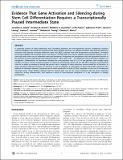Evidence That Gene Activation and Silencing during Stem Cell Differentiation Requires a Transcriptionally Paused Intermediate State
Author(s)
Golob, Jonathan L.; Pabon, Lil M.; Pratt, Gabriel A.; Loring, Jeanne F.; Laurent, Louise C.; Murry, Charles E.; Kumar, Roshan; Guenther, Matthew; Young, Richard A.; ... Show more Show less
Downloadjournal.pone.0022416.PDF (583.5Kb)
PUBLISHER_CC
Publisher with Creative Commons License
Creative Commons Attribution
Terms of use
Metadata
Show full item recordAbstract
A surprising portion of both mammalian and Drosophila genomes are transcriptionally paused, undergoing initiation without elongation. We tested the hypothesis that transcriptional pausing is an obligate transition state between definitive activation and silencing as human embryonic stem cells (hESCs) change state from pluripotency to mesoderm. Chromatin immunoprecipitation for trimethyl lysine 4 on histone H3 (ChIP-Chip) was used to analyze transcriptional initiation, and 3′ transcript arrays were used to determine transcript elongation. Pluripotent and mesodermal cells had equivalent fractions of the genome in active and paused transcriptional states (∼48% each), with ∼4% definitively silenced (neither initiation nor elongation). Differentiation to mesoderm changed the transcriptional state of 12% of the genome, with roughly equal numbers of genes moving toward activation or silencing. Interestingly, almost all loci (98–99%) changing transcriptional state do so either by entering or exiting the paused state. A majority of these transitions involve either loss of initiation, as genes specifying alternate lineages are archived, or gain of initiation, in anticipation of future full-length expression. The addition of chromatin dynamics permitted much earlier predictions of final cell fate compared to sole use of conventional transcript arrays. These findings indicate that the paused state may be the major transition state for genes changing expression during differentiation, and implicate control of transcriptional elongation as a key checkpoint in lineage specification.
Date issued
2011-08Department
Broad Institute of MIT and Harvard; Massachusetts Institute of Technology. Department of BiologyJournal
PLoS ONE
Publisher
Public Library of Science (PLoS)
Citation
Golob, Jonathan L. et al. “Evidence That Gene Activation and Silencing During Stem Cell Differentiation Requires a Transcriptionally Paused Intermediate State.” Edited by Eliana Saul Furquim Werneck Abdelhay. PLoS ONE 6, 8 (August 2011): e22416 © 2011 Golob et al
Version: Final published version
ISSN
1932-6203